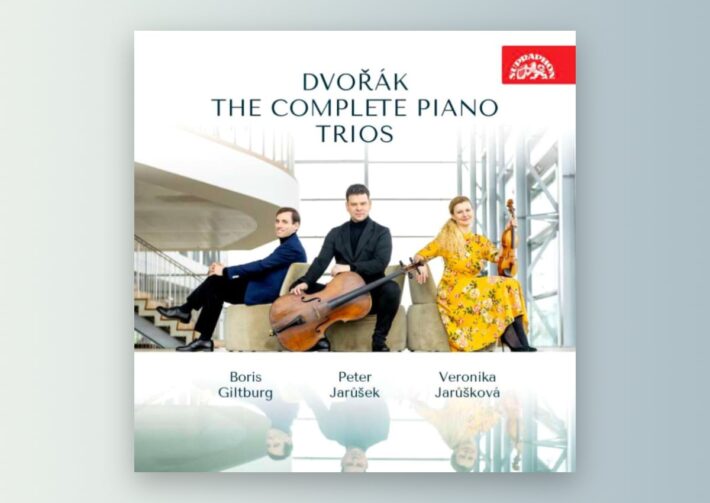In this double volume, pianist Boris Giltburg joins forces with Pavel Haas Quartet members Veronika Jarůšková (violin) and Peter Jarůšek (cello) on a journey through Dvořák’s four piano trios, which traverse a 20-year compositional period. I had reviewed a fine Shostakovich effort from the quartet for the same Supraphon label in 2019, so I especially looked forward to what this new partnership had to offer.
While there isn’t a plethora of complete cycle recordings, the Borodin and Beaux Arts Trios do give us two established reference points. Admittedly, the latter two trios take up more of the spotlight where popularity is concerned, but the earlier ones are certainly not to be passed over.
The group’s version of No. 1 in B-flat major I found delightful because it’s so youthfully innocent. The opening movement glows with a pastoral charm thanks to Giltburg’s shimmering tone and Jarůšková’s tender treatment of the violin’s singing lines. Plaintive reflection defines the beautifully performed Adagio Molto (track 2): what I especially appreciated was the seamless communication between the piano and cello. In their duo moments, there is a sense of complete familiarity, a true blending of expressive colors and beautifully crafted phrases.
Coy elegance and a dance-like lilt in the Allegro Scherzando (track 3) will invite even the most serious listener in. The carefree aura, however, is the work of carefully and well-thought out playing: listen closely for just how pristine articulation and phrase shaping are. The Finale in some ways takes the best parts of the previous moments: for instance, we hear effortless lyricism complemented in other parts by crisp and playful staccatos. But what stood out the most to me were the “tutti” moments. In unison, it becomes obvious that the members have an inherent understanding of each other and, thus, exactly how to blend voices to create a surprisingly full, orchestral sound.
Related Posts
- Review: An Invitation at the Schumanns’ – Trio Dichter
- Review: Dvořák – Chamber Works – Jan Vogler
- Review: Dvořák – Poetic Tone Pictures – Leif Ove Andsnes, Piano
The G minor Trio (No. 2) possesses a similar sense of synchronicity and refined artistry. The Allegro Molto (track 5) sees Dvořák weaving thematic and motivic patterns throughout different parts and the performers execute these handoffs lyrically and organically. The Largo embraces a similar sort of texture but with the added feel of a conversation between three characters: one wise (cello), one nostalgic (violin), and one graceful (piano). The latter two movements are where more foreword personalities emerge—in the third movement, for instance, the trio introduces us to a sprightly spirit that, while elegant, also has hints of an indomitable mischievousness.
The final “Dumky” trio is so named for its six folk-style “dumka” which range from rhapsodic to elegiac to contemplative. The work’s artistic challenge lies in how Dvořák often starkly juxtaposes these divergent emotions—often in close quarters—within each movement. For instance, the E minor Lento (track 13) requires an almost immediate shift from passionate urgency to melancholic resignation. The cello is largely responsible for this metamorphosis, and Jarůšek’s transition is on point in pacing and mood. Another highlight is the rather rare opportunity to hear a strings-only dialogue; Jarůšková and Jarůšek definitely don’t disappoint, giving us harmonies and sliding dissonances that are velvety smooth yet clear as a bell. The Poco Adagio (track 14) offers a more intimate look into light-dark contrasts via shifts between major and minor tonalities. The quiet, however, is not without a twist: the trio’s transition from the most intricate shades of piano to an energetic, raucous folk dance is indeed well-conceived and effective.
My favorite dumka was the Andante (track 15) that showed the group’s imaginative interpretation and musical versatility. The aforementioned acapella string texture returns (0’15”) and is easily reminiscent of the calm hum of sounds on a quiet evening. This belies a full-on burst of electric energy a few minutes later that, at its most intense, jabs with sharp ferocity. I actually preferred this performance to the Beaux Arts Trio’s (which is undoubtedly top-notch): Beaux Arts gives a little more insistence to the quieter sections to create forward movement in the static textures. However, the almost atmospheric quality of Giltburg et. al’s performance is what creates true magic and heightens the drama when it hits.
I found this disc an example of chamber musicianship at its best: the excellent sound engineering balances and blends parts, which underscores the ensemble’s successful delivery of Dvořák’s most sensitive nuances and extroverted peaks. Listening to all the selections in succession, we are treated to a vibrant experience indeed—but one in which the distinctive essence of each trio is aptly captured.

Dvořák – The Complete Piano Trios
Veronika Jarůšková – Violin
Peter Jarůšek – Cello
Boris Giltburg – Piano
Supraphon, CD SU43192
Recommended Comparisons
Beaux Arts Trio | Borodin Trio | Kim, Ma, Ax | Trio Wanderer
Read more classical music reviews or visit The Classic Review Amazon store
Follow Us and Comment:
Get our periodic classical music newsletter with our recent reviews, news and beginners guides.
We respect your privacy.








